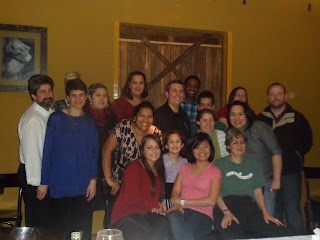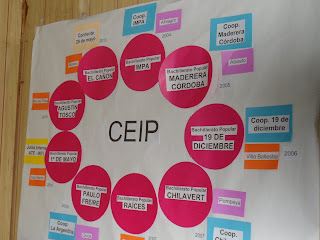

Tuesday was our big excursion to Uruguay. All of us except Elizabeth and Jennifer came along -- they had a plan to visit with Marianela, to learn about her organizing with unemployed workers. Our destination was the city of Colonia del Sacramento, which is a UNESCO World Heritage Site. (
http://www.coloniadigital.com/) It is a beautiful colonial town with some original buildings from 1680, museums, a lovely town square, the original fortified walls and cannons, rough cobblestone streets, palm trees and orange trees, and miles of sandy beach just outside the old city.
We took the colectivo (public bus) to the Buquebus terminal near Puerto Madero and, after going through passport control to leave Argentina, we boarded the fast ferry (one hour each way). The morning started out perfectly warm and sunny, and we thought we were in luck. Then the clouds started rolling in. By the time we got off the boat it was gray and overcast, and by the time we walked into the old city, it was raining. Then it started pouring. We split up -- some people wanted to see the museums, others wanted to shop, and others wanted to have a nice lunch. A group of us started by climbing the very narrow spiral staircase to the top of the faro, the 19th century lighthouse. We had a good view of the old town and the coastline, and we took photos (above). We could see the results of the 100-year war between Spain and Portugal over this territory -- the Spanish buildings have flat roofs, while the Portuguese used rounded red tiles (the architects among us could tell you the correct terms). Colonia was the object of much conflict between the two empires -- it went back and forth between Spain and Portugal for 100 years, then after a treaty in 1777 it belonged to Spain, until Brazil seized the territory in 1816. After some fighting between Brazil and Uruguay, Colonia became part of Uruguay, and has stayed that way since 1828. Next to the lighthouse are the ruins of an old convent, the oldest remains of a building in all of Uruguay, from the original settlement in 1680.
By the time we came down from the lighthouse, it was pouring rain, and most of us were not prepared; some were wearing flip-flops, no one had an umbrella or rain gear, and Ruthie (who is 7 and a half) was still in tears about leaving her favorite jacket on the public bus in Buenos Aires, never to be seen again. So we found a tour guide with a van, and she called her friend with a taxi, so that all 16 of us could have a driving tour of the city. They took us around the old city, and also up the coast to see the white sandy beaches and new housing developments (built mostly by foreign investors, some costing up to $800,000 US, which almost no Uruguayans can afford). She showed us the old horse racing track (hipodromo), which is still used on Sundays, and the famous old bullfighting ring. This huge stadium with Moorish architecture was built in 1910 and held bullfights until 1912, when the president of Uruguay decided that killing bulls was barbaric and closed it down. It has been empty ever since, with each successive president vowing to restore it for use as a theater, but meanwhile the walls are starting to crumble.
Our tour guide, Beatriz, was a character. She made us laugh with her description of a tree that they call "borracho," translated as "the drunken tree." As she told us, "it has those pink flowers that look like orchids, and Spanish moss hanging on it, and in the spring it grows those big fruits that look like avocados, but they're not, you can't eat them, they have something like cotton in the inside, and in Chile and Bolivia they make pillows out of it, but here it is useless." She said these things very quickly and definitively, as if it was all obvious and we knew all about it, and then she moved on to the next thing and we were left scratching our heads.
After the tour, we ended up in the new city of Colonia, at a restaurant called Mercosur that served "chivito," that local specialty -- I think it typically consists of fried potatoes on the bottom, then a piece of beef, fried egg on top of that, and finally bacon, and lettuce and tomatoes on top. Some of the students enjoyed it. Since we still didn't want to venture into the rain, we stayed at the restaurant, and for dessert we got the biggest slices of cake I have ever seen. We took the 9:30 p.m. ferry and got back to the hotel just before midnight, slightly soggy but with a "Uruguay" stamp in our passports.























































